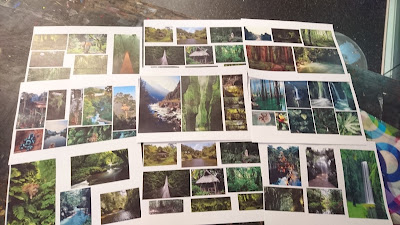Creative Play - Presenting our final piece
Today we presented our final piece for the Into to Creative Play module, and I feel as though we done so successfully. For the setup, we wanted to have the video projected above our physical piece which was placed upon a table. We had some issues during this phase, as it was difficult to have both pieces visible to the audience due to the placement of the projector, so next time we will definitely put more thought into the presentation prior to the event, however after altering the placement we overcame this issue, and I feel we shown the work in the best possible way. Though we sometimes needed to be asked questions during presenting to get ourselves to speak, we still managed to get across our ideas and evaluation of the piece successfully, and the feedback was constructive and appreciated.
I think we took a few risks during this project in the
spirit of creative play. For example, instead of sticking with our initial idea
to just present our work on boards, we expanded it further by not only creating
a more unique and interactive way of presenting our work, but also producing a
video along side that, which is something that I’m very glad we decided to
experiment with, as I feel that became the centrepiece for our project. Making
models of things is something that no-one from my team had much experience
with, hence the way we were originally settling on presenting our work on
boards, but I feel due to all the experiments and prototypes which we created,
we became a lot more experienced in the matter and I think the development of
the piece shows this. Despite wanting to take risks, we also ensured that each
team member had a task which utilised their unique talents, in order to make
the final piece as good as it could be, for example Alice used her talent with
watercolours to produce the traditional artwork, I used my digital design
skills to produce the modern artwork, and Juntong used his knowledge of editing
software to start the production of the video. I feel as though we all contributed
to the ideas generation phase of this project, however as I previously
mentioned, we were purposely put into groups with two others with contrasting
work styles, and those stayed true throughout the topic, as Alice was classed
as more of a creative type, and I was one who preferred to be told what to do,
which is why Alice contributed the most during the ideas generation phase, and
me and Juntong took more of a role during the building of the product.
The brief I feel was met as the theme of old and new was
pretty much the founding concept for our project, we added a slight interactive
element through the sound and the way in which the piece leads your eye from
the jungle to the modern city, we created a physical product, and energy is
shown during the transitioning phase of the video. If we were to improve on any element of the piece, I think my group would all agree that we could have made the interactive element more apparent and also altered the scale of the model, as I feel it was small, especially when placed below the projection of the video, however this was prevented due to the size of card on offer. Overall though, I am very satisfied with our result, and the other displays were also very well done.










































